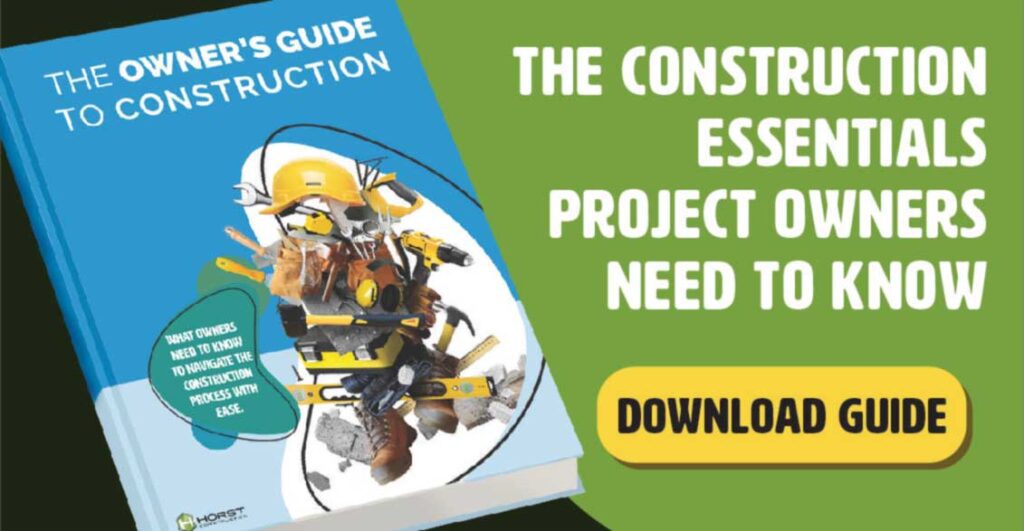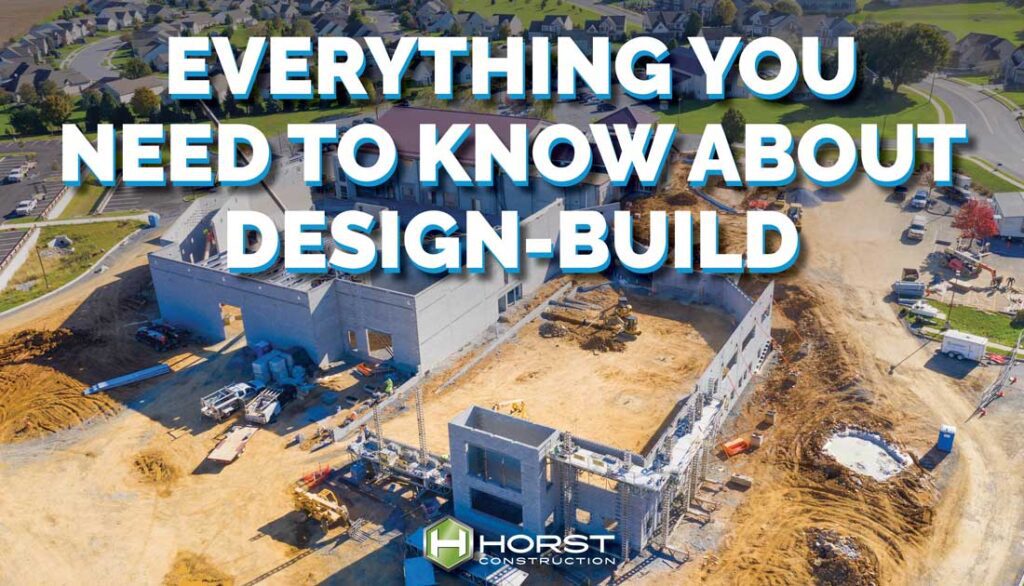
This year, it’s expected design-build will become the delivery method of choice for nearly 50% of construction projects[i]. What was once considered an alternative method to design-bid-build and construction manager at risk is quickly becoming the preference.
If you want to know how this popular construction approach is different from the traditional methods, you’ve come to the right place. In this blog, we’ll take a look at what makes a design-build project, what the team structure looks like, and what steps are involved. Then, we’ll finish off with an example of a design-build project.
- What is a Design-Build Project?
- What Does a Design-Build Team Look Like?
- Design-Build Process Steps
- Example of a Design-Build Project
- Is Design-Build Right for My Construction Project?
What is a Design-Build Project?
Design-build is a type of delivery method for construction projects. Differentiated by how the team is organized and how information flows throughout the project’s stakeholders, design-build is known for its ability to foster collaboration and reduce the risk and burden held by the project’s owner.
Unlike other delivery methods, design-build’s project team structure unites everyone under one shared goal: the success of the project as a whole – not just their respective portion. Because each firm’s success is measured by how well all the other firms do, design-build fosters a collaborative atmosphere where knowledge and expertise are shared.
The owner typically has one main point of contact who then enters into contracts with the architect, engineers, and other partners on the owner’s behalf. This often translates to shorter schedules and lower project costs.
A recent study by the Construction Industry Institute compared 350 projects with varying project delivery methods. They found that design-build projects were completed more quickly and cost less than the two other leading project delivery methods, design-bid-build and construction manager at risk[ii].
Because of the increased efficiencies of design-build, the owner can take on fewer duties and less risk. The design-builder will step in for much of the risk management, potential legal burdens, and administrative tasks.
These are tasks that take up valuable time but have little effect on the overall project, like coordination of the project team, paperwork, documentation management for submittals and RFIs, understanding and managing contracts and legalese, and playing the “middleman” between parties.
It’s important to note that by shifting these tasks over the design-builder, the owner doesn’t lose power or control over the project. Their time and resources have been freed up to either focus more on the aspects of the project that are most important.
What Does a Design-Build Team Look Like?
To fully understand what makes design-build unique among construction delivery methods, we’ll have to look at the organization of the team.
Unlike other project delivery methods, the project owner only has one point of contact – the design-build firm. It’s this design-build firm’s responsibility to represent the owner’s best interests and work collaboratively with all other parties involved in the construction of the project, from the design team to the subcontractors. The design-builder will typically take on the burden of coordinating, hiring, and holding the contracts with these other firms, as well as handling any problems as they arise.

This doesn’t mean that the owner loses control over the project team and the design-builder makes all the decisions independently. The owner maintains 100% power over the project. However, the design-build firm is there to guide them and act on their behalf, taking on a substantial amount of the project’s burden and risk that would typically fall to the owner in other project delivery methods. They’re there to support you and make the process easier – not dictate what you can and cannot do.
Design-Build Process Steps
The design-build process can be broken down into five main steps: team selection, project planning, design, GMP/bidding, and construction. For the most part, these steps will happen sequentially, but not necessarily independent of one another. The project planning, design, and bidding phases may overlap. Construction may kick off while some of the project is still in the design phase. Ultimately, it will depend on your specific project and your goals.
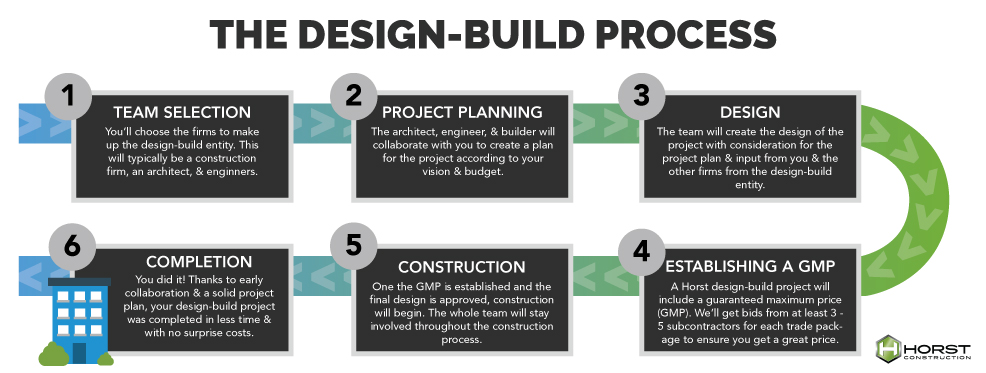
Each step in the process will typically include the following:
1. Team Selection
During the team selection phase, the owner will choose the firms that will make up their design-build team. This often includes the builder, architect, and engineers. Depending on the owner’s preference, they will either select one firm who will then choose the other members of the design-build team, or the owner will play an active role in the selection of all the firms that make up the team.
Regardless, these teams will band together contractually to form your design-build team. The success of the entire project will be their goal, as opposed to the success of just their area of expertise. This motivates them to work together from the start, looking at the big-picture success of the project.
2. Project Planning
Once the design-build team is assembled, they’ll begin to plan out the project. They’ll match up your vision and goals for the project with your budget, and develop preliminary drawings, cost analyses, and schedules. They’ll analyze the project’s site and any existing structures or utilities located on the site, and they’ll look for potential challenges so they can prepare and plan accordingly.
3. Design Phase
Once the preliminary drawings fit into the rest of the project plan, the design phase begins. This is when the architect will complete the final drawings for the project.
Unlike with the design-bid-build project approach, your project will benefit from having the input of the architect, builder, and any specialty subcontractors during this stage. This will lead to more accurate drawings, reducing the risk of constructability issues and change orders down the road.
4. Establishing a GMP
Next, the builder will assemble a more defined cost for the project. At Horst Construction, this includes at least three to five subcontractor bids for each trade package and a guaranteed maximum price (GMP).
A common concern with the design-build approach is that a project will cost more because the work won’t be competitively bid. However, that’s not the case. We make sure to get viable bids from a suitable amount of trusted, quality subcontractors, so you can be sure you’re getting a fair price.
In addition, your project will be secured with a GMP. A GMP is a set price for the project backed by the design-builder. It’s a promise that the project’s cost won’t go above that specific price. If it does, it’s the responsibility of the design-builder to pay—not the owner.
All Horst Construction design-build projects will put trade packages out to bid and include a GMP. But this won’t be the case with all design-build teams. We believe this is the best way to ensure the owner gets the fairest price for their project. Click here to learn more about what makes our design-build services unique.
5. Construction
Once the design is finalized and the subcontractors and suppliers are selected, the project will begin construction. Because of the early collaboration on the part of the project team, the project should go relatively smoothly. The design-build approach has been shown to reduce or even eliminate the need for change orders and helps keep costs in line with the budget.
However, there is always the potential for unforeseen challenges to arise. But because the project rests on a solid plan from the beginning, the team will have more bandwidth to deal with challenges as they occur.
Once construction wraps up, the project will close out and the owner can move into their new building!
Example of a Design-Build Project
Spurred on by the collaborative approach it offers, Lancaster Bible College chose the design-build project delivery method for the construction of the new Teague Learning Commons. Upon completion, this 41,500-square-foot building spans three stories and serves as the campus’s collaborative learning and research hub.
Once they chose their team of Horst Construction, Cornerstone Design Architects, and Providence Engineering, the project preconstruction and design phase kicked off. And because these key players could all bring their unique expertise to the table in the planning phase, the project was better off.
“We choose the design-build process because it gives us the maximum amount of input right there at the table. We have everyone seated around the table,” reflects John Zeswitz, the Executive Vice President of Lancaster Bible College at the time of construction. “It gives us the opportunity to understand the impact of some of the choices and discussions that we’re having.”
By having the key players involved in the initial planning phase, Lancaster Bible College could communicate their vision for the project as the design-build team worked together to find the best path towards making that vision a reality.
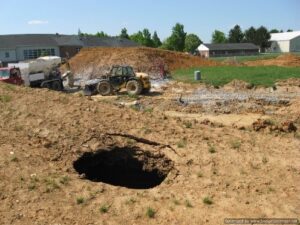
Unlike a design-bid-build or construction manager at risk scenario, the project was designed with input from the construction team. This more collaborative approach leads to a more realistic plan. And having a solid plan gives the team more bandwidth to deal with the inevitable, unforeseen challenges that can arise once construction kicked off.
One of these challenges came from mother nature herself in the form of record rainfall topping 20 inches in just four months. The 30 415-foot-deep geothermal wells, elevator shaft, basement, and foundations all required significant excavation work under extreme conditions.
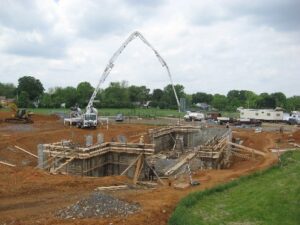
In addition, several large sinkholes were uncovered and made worse by the excessive rains. In response, the team had to quickly relocate some of the geothermal wells and add sinkhole remediation into the project schedule.
Because of the collaborative approach of the design-build method, the team was able to quickly adjust to these challenges and move the project forward to its successful completion.
“The design-build gets much more of a collaborative conversation going earlier. And we found that that yields trust, and trust goes a long way in the construction of a facility,” shares Zeswitz.
Is Design-Build Right for My Construction Project?
Overall, design-build can benefit projects of any size and budget. This method establishes early collaboration in the project’s planning and design phases which leads to fewer problems down the road. That often translates to lower project costs and quicker project schedules. The streamlined communication flow and reduction in both burden and risk for the owner make the process easier and more efficient.
However, the best decisions are ones that are made when all options are considered. For more information on the other project delivery methods, check out this blog. You can also take our short quiz that will help you determine which project delivery method is best for your project!
[i] Construction Dive Report: Design-Build to Deliver Almost Half of US Projects by 2021
[ii] Construction Institute: Design/Build (Archived) – RT-133 Topic Summary
Oops! We could not locate your form.
